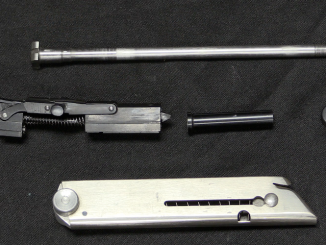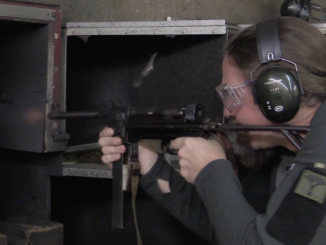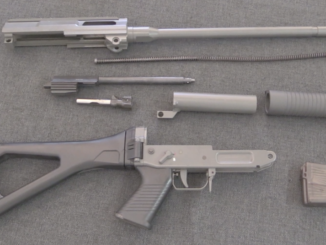The SIG KE-9 and M29A were several in a series of developmental rifles made by SIG in Switzerland and designed by Pal Kiraly. These ultimately found no commercial or military sales, although the related KE-7 light machine gun did have some limited success.
Related Articles

Conversion
Erma/Glaser Luger .22 Rimfire Conversion
This conversion kit is lot #1713 in the upcoming Rock Island May 2019 auction. In 1927, a Berlin resident named Richard Kulisch patented a .22 rimfire conversion kit for the Luger pistol. Kulisch’s conversion used […]

Submachine Guns
The Swiss Cheap Out: SIG 310, aka MP48
The SIG 310, aka MP48, is the final evolution of SIG’s submachine gun design from the 1920s. It began as the MKM/P/S/O with a folding magazine well, wooden stock, and fancy lever-delayed operating system. Over […]

Bolt Action Rifles
SIG’s Pump Action 550 Rifle: the 550 VRB
In many countries, manually operated rifles are substantially easier for civilians to own than semiautomatic ones – and this was not lost on firearms manufacturers. In an effort to potentially open a new market, SIG […]

What is the time period for these?
Pal Kiraly’s surname is pronounced “Kir-eye” and his name translate from Hungarian as “Paul King”.
I have always been interested in his use of lever locking systems, and I would find it very helpful if you ever got hold of one these examples to go over this method of operation.
“his use of lever locking systems,”
Modern Firearms in SIG Neuhausen KE-7 light machine gun query:
http://world.guns.ru/machine/switch/sig-ke-7-e.html
states that KE-7 is 7th, then I assume KE-9 is 9th, do you have any information about KE-1 or KE-2 or KE-3 or KE-4 or KE-5 or KE-6 or KE-8? It also states that KE is for Pal Kiraly and Gotthard End. Do you have any information about latter?
Kiraly also filed US 1985493 A titled Automatic or self-loading gun
https://www.google.com/patents/US1985493
It looks like they eject straight up, which is less than optimum for an SLR. I have to wonder if this design started out as an LMG with the magazine on top, ejecting out the bottom. Just a thought. For what it may be worth.
Wafa Wafa, Wasara Wasara.
What would be the psychological effect of seeing the whole mass of the bolt cover coming back at you ? Another reason it didn’t fly ?
If I understood it right, the recoiling bolt stays under the bolt cover, which only comes fully backward when grasped and pulled back by the user.
The charging handle doesn’t recoil with the bolt, which is a good thing in this case. Similarly, most (if not all)light machine guns and GPMGs from the 1930’s onwards have non-reciprocating charging handles (what I mean is that the charging handle sit still during the firing cycle as it is not attached directly to the bolt). The charging handle of the KE series likely has its own groove alongside the bolt, and yes, will only engage with the bolt when the user pulls the handle and then releases it.
Did I flub this assumption?
That’s how the KE7 bolt retraction handle works, plus the ZB26/Bren family, etc. It’s basically a safety feature; you really don’t want that thing racketing back and forth to catch the gunner’s off hand.
Most of the weapons that have that setup unashamedly copied it from the Browning Automatic Rifle, which was one of the earliest to have it. It used to amuse me to see police officers who were not familiar with the BAR try to check and clear or chamber it by reaching up for a bolt handle on the right side, only to realize there wasn’t one. I had to demonstrate the correct drill, with the right hand holding the weapon by the stock wrist and the left operating the bolt retractor low on the left hand side of the receiver.
Strictly speaking, the KE7 isn’t an LMG. It feeds from a box magazine, has only a bipod, and has no quick-change barrel. It is in fact a machine rifle, mainly intended to be fired from the standing or hasty prone position in support of an assault, or on single-fire against point targets at long range (beyond 250 meters).
(It would help if the KE7 had a single-fire selector; the one I examined OUAT only had “safe” and “overdrive”.)
The BAR is another example of such a weapon, and was in fact the first true machine rifle in the world. They are a very useful class of weapon that is almost entirely misunderstood today. Although the people making the new Ohio Ordnance Works HCAR version of the BAR seem to have a pretty good grasp of the concept and its proper tactical role.
cheers
eon
The original M1918 variants were treated as squad automatic weapons for suppressing fire (which they probably did somewhat well), but I believe the FN Model D would fill the role much better, having a more ergonomic stock (full pistol grip), a bipod on the gas tube rather than the barrel, and a quick detach barrel for obvious reasons. The Poles made an aircraft MG based on the M1918, the Karabin maszynowy obserwatora wz.37, which had a cyclic rate of 1100 rounds per minute and a 91 round drum. Strange, isn’t it?
The M27 IAR used by the USMC has a similar “machine rifle” role, so at least some seem to understand the concept today, although others have also criticized it for providing insufficient volume of suppressive fire.
What I always wonder is when a barrel recoils at all, how does that throw your aim off.
My guess would be it will impact shoulder just like bolt or gas operated gun. There is not any sign of impulse attenuation in this design.
Stock design has a lot to do with it. Generally, the closer the bore line is to the comb of the stock and thus the centerline of your shoulder and collarbone, the less rise or other divergence from the line of sight you’ll have. However, that also means the recoil is going to come straight back at
your shoulder, and with a heavy-caliber weapon firing full-auto, you’re in for a pounding, especially when firing prone.
Yes, the TANSTAAFL* rule applies in physics, too.
(*TANSTAAFL- There Ain’t No Such Thing As A Free Lunch, generally attributed to Robert A. Heinlein.)
cheers
eon
“Yes, the TANSTAAFL* rule applies in physics, too.”
It must be remembered that fire-arms have to comply with Newton’s law stating:
ACTION = REACTION
Interesting to see the work Kiraly has dome prior to his ultimate retarded recoil carbine. It does not seem to me, at least from my prospective, that design is too complex; the internals would have to be completely removed to have full impression.
It is a gorgeous design with traditional Swiss machining – lovely to look at.
….should have been “retarded blow-back” in more pure sense.
Does the M29A bolt fit and work as intended in the KE? I’m somewhat sure that the adjustment to the bolt machining isn’t the whole change there.